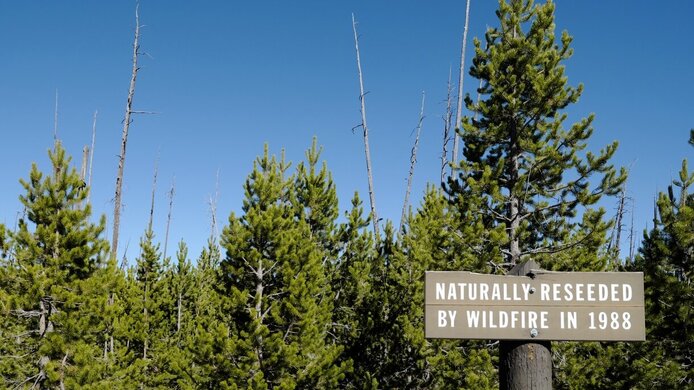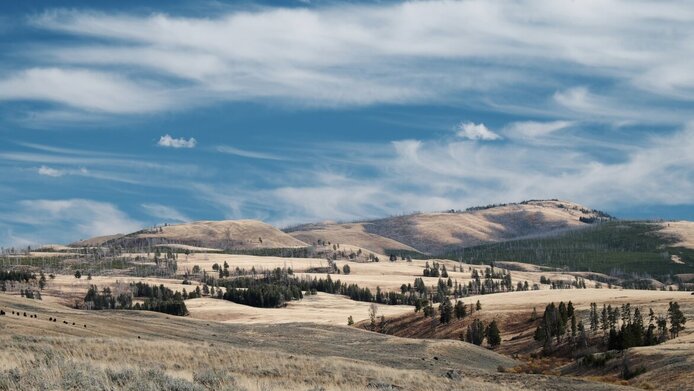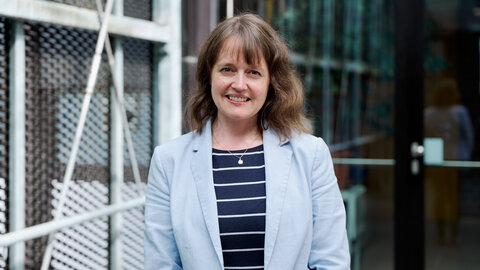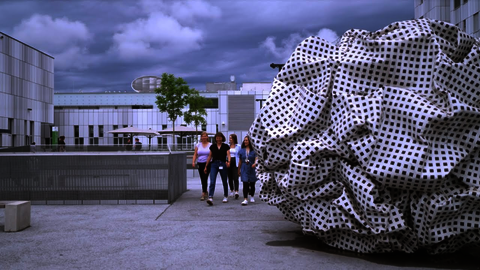Forest man – working hand in glove with practitioners
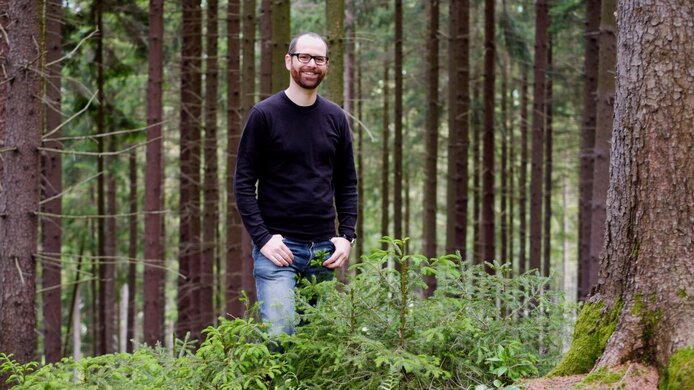
In June 2018, the government of Lower Austria provided €1 million as an emergency measure to prevent bark beetle damage. In the previous year, Lower Austria’s 35,000 forest owners suffered a total financial loss of €35 million. A total of 1.5 million solid cubic metres of wood were infested by the bark beetle. The Waldviertel region was particularly affected. “Because of the hot and dry spring, the problem could be even exacerbated this year, as the beetles were able to start multiplying even earlier”, warns Rupert Seidl, a professor at the Institute of Silviculture at the Vienna University of Natural Resources and Life Sciences (BOKU).
Bark beetle biotopes
Quite generally, trees have evolved a well-adapted defence system against the bark beetle, which consists of resinifying the intruder. In the forest ecosystem, the beetle also fulfils an important function: bark beetle infestation results in the death of weakened trees and thus initiates forest rejuvenation. In addition to the natural spruce forests found on higher mountain ranges, humans have created optimal biotopes for bark beetles by planting extensive spruce monocultures at low altitudes. “In extreme climate conditions, for instance long periods of heat or drought, the beetles specializing in spruce as a host, such as the European spruce bark beetle (Ips typographus) and the six-toothed spruce bark beetle (Pityogenes chalcographus), can multiply explosively”, explains Seidl. The climatic changes have an additional effect: when it gets drier, the trees cannot produce enough resin and thus cannot defend themselves adequately against the beetles.
Biodiversity
A short-term measure is to remove trees that carry a high risk of being infested. Once the beetles have colonised a tree, it dies. “This is a race against time”, notes Seidl in respect of this measure. In the longer term, it is more effective to create mixed forests where the spruce bark beetle cannot spread as quickly. “The general principle is: the higher the biodiversity, the less susceptible the system is”, says the scientist. And he goes on to specify: “If there are not only different tree species, but also natural predators of the bark beetle, such as birds, wasps and other beetles, you can reduce the long-term risk.”
Disturbances
In his FWF-funded START project Forest disturbance in a changing world the silviculturist is investigating disturbance processes in Central European forests. Besides the bark beetle, these processes include mainly windthrow and forest fire. However, researchers speak of a disturbance process only if trees die relatively abruptly and over large areas.
Disturbances also have positive aspects
In his field of research, Seidl concentrates on national parks in order to investigate processes that occur naturally and are not affected by human intervention. The scientist was surprised by the results of his research: “Disruptions do have some positive aspects, for example for biodiversity. They increase niches and the diversity of habitats. Deadwood, for example, is an important forest habitat. The forest ecosystem has adapted to disturbances over a long period of time and can handle such events very well”, explains Seidl. But the human factor and the functions that the forest is expected to fulfil need to be considered as well: on the one hand, the forest is supposed to give protection against natural hazards, and on the other it is an important source of timber. “There will still be forests in a warmer climate in the future”, says Seidl, “the question is only whether this will be the forest we want to see in an area where nature is used as intensively as in Central Europe.” Hence, disturbances are good for biodiversity, but they are not conducive to what we humans need from the forest.
“Immune response”
Another exciting result of the young researcher's START project was prompted by the question of how a forest would change over 100 years if the temperature rose by 3 to 5 degrees. This rise in temperature corresponds to the climatic difference across several hundred metres in altitude, but 100 years is not even a single generation of trees. “The disturbances lead to new species establishing themselves faster so that the system can adapt more quickly to the new conditions. This is almost like an immune response of the forest”, says Seidl, but underlines that “faster” still means several centuries. - The temporal dimension of a forest is substantially more long-term than the human planning horizon.
Risk and resilience
What can we learn from these research results? Despite the efforts of forest managers to avoid disturbances, they have tripled in Europe over the past 40 years. “In many places, it will require heightened forest management efforts to maintain stable forests that still fulfil their functions. In other areas, the positive effects of disturbances should be used where they benefit diversity and the self-regulation of the system”, says Seidl. This is his credo: focusing more on questions of risk and the regenerative capacity of forests in forest management and paying more attention to issues of stability in planning.
“No overprotection”
However, one should not be overprotective, as this has turned out to be counterproductive. Seidl quotes the example of forest fire prevention in the western United States. In the 20th century, the authorities were very effective in having any fire put out immediately, which has led to the forest becoming denser. If a fire breaks out nowadays, it is much more difficult to contain because there is more combustible material. “Today we know that it would have been good for many of these systems if there had been smaller-scale fires every five to ten years”, says Seidl, adding in conclusion: “Working against natural processes rarely does the job.”
Global species loss a hundred times higher
Even though the forest ecosystem has a high degree of resilience, Seidl’s analyses are very clear about one aspect: “If disturbances caused by climate change become more severe, there may be a point at which the system collapses and no longer regenerates.” Apart from the rise in temperature, Seidl sees the loss of species as one of the biggest problems: “Globally speaking, the loss of species is a hundred times greater than would be expected on the basis of natural processes. If many species are eliminated, the system can cross a critical threshold and cease to fulfil many of its functions”, warns the researcher.
Drought-induced changes
One example of critical thresholds having been exceeded is provided by studies in the Yellowstone National Park in the northern Rocky Mountains of the USA. “The results show that with increasing incidences of drought and forest fires, the forest could turn into an open, savannah-like grassland”, notes Seidl. His investigations in Central Europe on this issue have not yet been completed. His assumptions are that forests will continue to exist in large parts of the Alps despite rising temperatures and increasing disturbances. “However, we will probably see the system shift towards more deciduous forests”, says the scientist.
No forest dieback in the 1980s?
But isn’t it a fact that forests have recovered after clarion calls about forest dieback were sounded in the 1980s? Seidl points out that in comparison with the 1980s the situation is much more difficult today: “At that time, the sulphur load was limited to certain areas and could be reduced by more than 90 percent by means of filter systems. The CO2 emissions that produce climate change, on the other hand, are global, and fossil fuels have been the basis of our economic system for over 150 years.” Moreover, the media outcry generated great interest in the forest at the time, and more money was invested in research. “A great many things that we are researching today are based on the results of a special research area financed by the FWF at that time”, Seidl notes.
“iLand” – playing out climate scenarios
In the context of the debate on forest dieback in the 1980s, many testing sites were established which still provide valuable forest data today. However, the longevity of trees also requires longer observation horizons. Seidl achieves this with the help of the “iLand” http://iLand.boku.ac.at forest landscape model he has developed to simulate entire landscapes on the computer: using these models, researchers can reproduce the fundamental processes occurring in a forest and thus simulate the growth, death and rejuvenation of a forest on the computer. “We can run through the changes under different climate scenarios for the next 100 years”, says Seidl, describing one application of “iLand”.
Hand in glove with practitioners
The model is also used very extensively for forest management issues. With “iLand”, researchers can study, for instance, what happens if a different tree species is planted or if the diversity of tree species at a certain location is increased. It also helps researchers to determine where a specific risk management measure has the greatest impact. “iLand” is a piece of scientific software, however, and not a tool that forest managers could simply use on their smartphones. The scientists run the simulations, process the data and on this basis have discussions with forest managers about what measures can achieve what effects. It has to be noted, however, that these discussions sometimes reveal differences between the model and reality. “Their feedback is very important for us because it raises new questions on which we then conduct a follow-up through basic research. Such a hand-in-glove approach is mutually stimulating”, comments Seidl on his cooperation with practitioners.
Forest – protector of the climate
The forest not only provides wood as a naturally renewable resource and offers protection against natural hazards, it also protects the climate because it absorbs CO2 and can store it for a long time. That is why the rapidly advancing global loss of forests is such a great threat, as it accelerates climate change even more. Nearly one third of the world's land area is covered by forests - in Austria the figure reaches almost 50 percent. The leaders in annual forest loss are Brazil and Indonesia. Among the causes one finds changes in land use such as soya plantations and cattle pastures in Brazil or palm oil plantations in Indonesia.
“The problem needs a bottom-up solution”
Seidl is not particularly optimistic that the problem of climate change can be solved in a top-down process, but hopes for bottom-up activities: “We can all change our behaviour – the way we eat, the way we use transport. It's up to us to do something.” He sees the responsibility of political decision-makers in providing incentives to adjust behaviour. The responsibility of science is to point out where there are problems and suggest possible solutions.
Transformation as an opportunity
What the young scientist would like to get from policy-makers is positive visions for the future. “We should see this transformation in which our society finds itself as an opportunity”, is the approach favoured by Rupert Seidl. He perceives
the greatest challenge as defining the paths of transformation: “We have a current state that we are not satisfied with, and we have a desired target state, namely a sustainable society existing in harmony with nature. What is at stake now is to find viable, concrete paths leading to such a positive development", says Seidl. He considers the search for these paths as a social process of democratic negotiation. Every citizen is called upon to become involved. “All it takes is the will to do it”, the 39-year-old researcher says with conviction.
Proportion of cyclists to be doubled
“Today, significantly more people in Vienna ride a bicycle than just a few years ago”, observes the native of Upper Austria, who cycles the distance between his home in Ottakring and his office in Währing every day and in all weathers. According to the climate strategy of the Austrian Federal Government, the proportion of cyclists is to be doubled. “I endorse this completely. But you also have to provide the necessary financial resources and appropriate incentives.” Studies show that overall transport behaviour changes once a critical mass of cyclists is reached. “In Vienna, we're not quite there yet”, Seidl smiles.
Ideas on the bike
Cycling is good for the environment and the rider’s health, but in Rupert Seidl’s case it also releases his creative juices: “Sometimes I rack my brains in the office all day to find the solution to a problem. When I get home, I will immediately write down an idea that came to me while riding home on my bike.” To be ready for such sudden insights, Seidl always carries his black notebook with him. Even during the time when he, who calls himself a “forest man”, is roaming in the Vienna Woods. That is something he greatly appreciates about Vienna, by the way: “In what other city can you take a tram to the forest?” Seidl’s collection of little black books already fills several shelves in his office.
Rupert Seidl is an Associate Professor at the Institute of Silviculture at the Vienna University of Natural Resources and Life Sciences (BOKU). His research interests include aspects of forest ecosystem dynamics in general and the role of the climate and disturbances in forest ecosystems in particular. He studied silviculture at BOKU and his research took him to Sweden, Finland and the USA. Among numerous other awards, he received an FWF START Prize in 2015 for his project Forest disturbance in a changing world.
